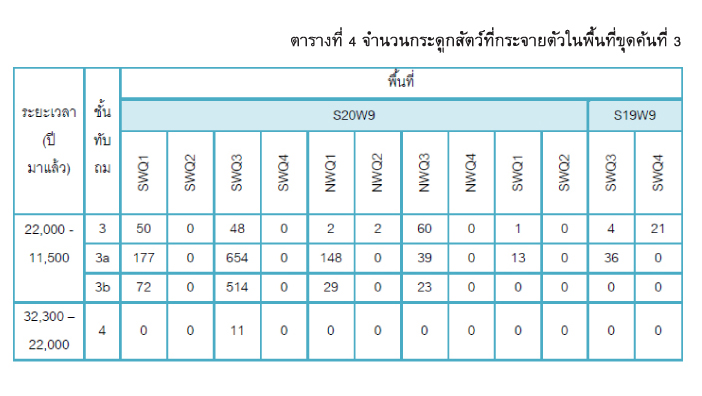
การจัดการพื้นที่อยู่อาศัยสมัยก่อนประวัติศาสตร์ : การศึกษาหลักฐานทางโบราณคดี ประเภทกระดูกสัตว์
DOMESTIC SPACE MANAGEMENT DURING THE PREHISTORIC PERIOD: A STUDY OF ARCHAEOFAUNAL REMAINS
โดย อนุสรณ์ อำพันธ์ศรี / By Anusorn Amphansri
Damrong Journal, Vol 11, No.1, 2012
บทคัดย่อ:
การศึกษานี้มีวัตถุประสงค์เพื่อแปลความหมายของแบบแผนการกระจายตัวของหลักฐานทางโบราณคดีประเภทกระดูกสัตว์ เพื่อทำความเข้าใจเกี่ยวกับการจัดการพื้นที่อยู่อาศัยของกลุ่มคนล่าสัตว์-เก็บหาอาหารในสมัยไพลสโตซีนตอนปลาย (ประมาณ 32,000-11,500 ปีมาแล้ว) ผ่านหลักฐานทางโบราณคดีประเภทกระดูกสัตว์จากแหล่งโบราณคดีเพิงผาถ้ำลอดโดยนำแนวคิดด้านสัตววิทยาโบราณคดี โบราณคดีเชิงพื้นที่ และชาติพันธุ์วรรณาทางโบราณคดีมาประยุกต์ใช้
ผลการศึกษาบ่งชี้ว่ากลุ่มคนที่เข้ามาใช้พื้นที่ในสมัยไพลสโตซีนตอนปลายน่าจะมีแนวคิดเกี่ยวกับการจัดการพื้นที่สำหรับกิจกรรมการอยู่อาศัยแล้วโดยสามารถแบ่งได้ดังนี้
1. มีการจัดการพื้นที่อยู่อาศัยตามหน้าที่หรือวัตถุประสงค์การใช้งานที่ต่างกัน โดยแบ่งเป็น 3 พื้นที่หลัก คือ พื้นที่ครัวเรือน พื้นที่ส่วนรวม และพื้นที่กิจกรรมพิเศษ
2. มีการจัดการเกี่ยวกับพื้นที่นอน และมีแนวคิดเกี่ยวกับความสะดวกสบายของการใช้พื้นที่
3. ไม่พบหลักฐานของการจัดการพื้นที่สำหรับทิ้งขยะ โดยพบหลักฐานของการทิ้งขยะในบริเวณพื้นที่กิจกรรมการอยู่อาศัย
การจัดการพื้นที่ข้างต้นปรากฏตลอดช่วงระยะเวลาของการปรากฏหลักฐานการเข้ามาใช้พื้นที่บริเวณแหล่งโบราณคดีเพิงผาถ้ำลอด (สมัยไพล-สโตซีนตอนปลาย) สันนิษฐานว่ากลุ่มคนเหล่านี้มีการเปลี่ยนแปลงแนวคิด และพฤติกรรมหลักเกี่ยวกับการจัดการพื้นที่น้อยมาก อาจเป็นไปได้ว่ากลุ่มคนที่เข้ามาใช้พื้นที่นี้ในแต่ละช่วงเวลาน่าจะมีความสัมพันธ์กันเชิงวัฒนธรรมก็เป็นไปได้
ABSTRACT:
The main objectives of this study are to analyze the distribution patterns of the Late Pleistocene faunal remains and to interpret the way prehistoric people utilized domestic space in their domestic activity areas at Tham Lod rockshelter. Results from the analysis show that the Late Pleistocene hunter-gatherers who occupied the rockshelter had specific behaviour regarding site/domestic space management, as follows:
1. The Late Pleistocene hunter-gatherers divided their domestic space into 3 distinct areas: a household area, a communal area, and a special activity area.
2. Evaluating space utilization indicates that they paid particular attention to a comfortable sleeping area.
3. Their refuse disposal patterns indicate that the site had probably been used several times by the Late Pleistocene hunter-gatherers as a temporary camp site, and that they had no specific space for refuse disposal.
This domestic space management had developed through time. It is assumed that the hunter-gatherer groups who occupied this site through the Late Pleistocene period might share the same way of thinking in terms of site/domestic space management. Moreover, they could possibly be the same cultural group.











